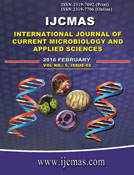


 National Academy of Agricultural Sciences (NAAS)
National Academy of Agricultural Sciences (NAAS)

|
PRINT ISSN : 2319-7692
Online ISSN : 2319-7706 Issues : 12 per year Publisher : Excellent Publishers Email : editorijcmas@gmail.com / submit@ijcmas.com Editor-in-chief: Dr.M.Prakash Index Copernicus ICV 2018: 95.39 NAAS RATING 2020: 5.38 |
The genus Contracaecum (Ascaridida: Anisakidae) is a nematode parasite belonging to fish-eating birds throughout the world. C. pelagicum causes gastrointestinal problems in the Magellanic penguin. The objective of this study was to evaluate the effect of an ovicidal fungus (Pochonia chlamydosporia) on C.pelagicum eggs under different concentrations (500, 1500, 2000, and 3000 per Petri dish).The ovicidal effect was evaluated in accordance with the visualized morphological changes tothe eggshell: type 1, physiological effect without morphological damage to the egg shell; type 2, lytic effect with morphological alteration of the eggshell; and type 3, lytic effect with morphological alteration to the egg shell and embryo in addition to hyphal penetration and internal egg colonization. At the end of the experiment, there was significant difference in egg destruction (effect type 3) in the four tested concentrations when compared to the control group. No difference was observed (P>0.01) for ovicidal activity between the four concentrations used. At the concentration of 3000 chlamydospores, a 46.2% of C. pelagiucum egg destruction was observed, after 7 days. A concentration of at least 500 chlamydospores was effective in destroying C. pelagicum eggs, suggesting a potential use for chlamydospores (P. chlamydosporia) against this nematode.
 |
 |
 |
 |
 |